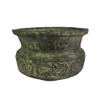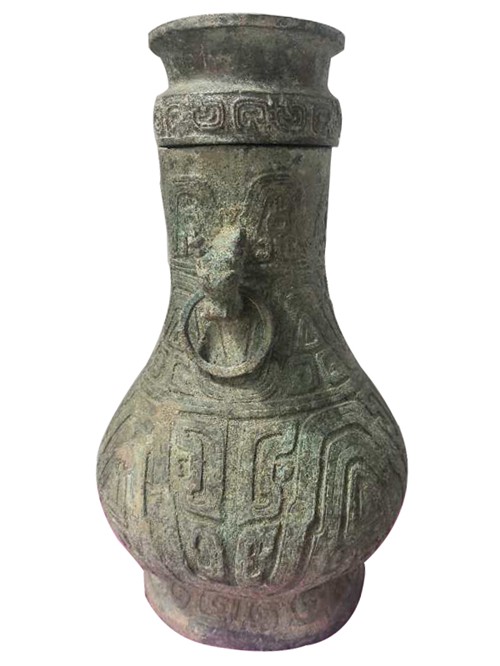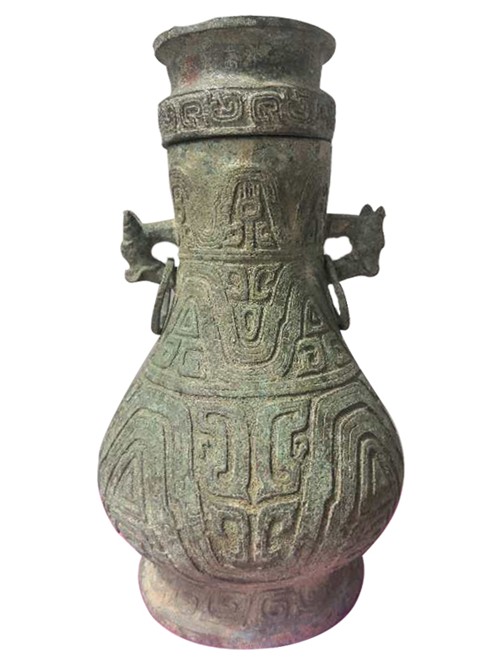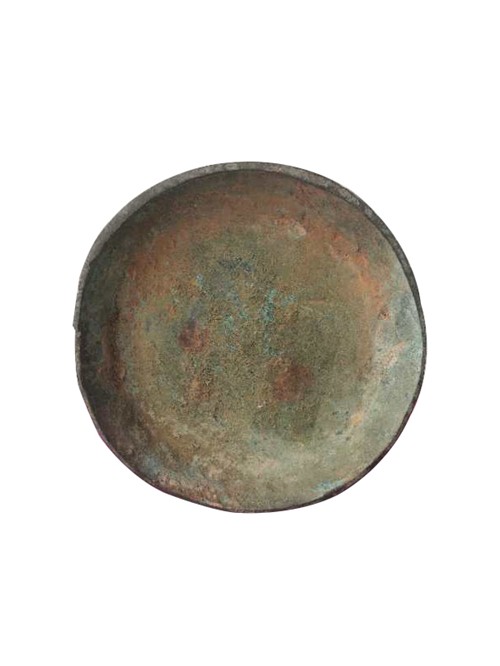分享到微信,
请点击右上角。
再选择[发送朋友]
或[分享到朋友圈]

西周晚期指厲王、共和、宣王、幽王等100多年時間,此期間青銅器的種類和形式减少,造型和紋飾都比較簡樸實用,且趨於定型化、程式化。經過西周中期新舊交替和轉變的過程,西周晚期的青銅器無論從形制上還是從紋飾上都是中期的延續,但是已經沒有中期那樣交錯複雜的情形了。這時出現少量新的器形,但整體的變化不大。
The late Western Zhou Dynasty refers to the period of more than 100 years, such as king Li, Gonghe, King Xuan and King Youwang. During this period, the types and forms of bronzes decreased, and the shapes and patterns were simple and practical, and tended to be stereotyped and stylized. Through the process of the alternation and transformation between the old and the new in the middle of the Western Zhou Dynasty, the bronzes in the late Western Zhou Dynasty were the continuation of the middle period in terms of shape and decoration, but there was no such complicated situation as that in the middle period of the Western Zhou Dynasty. At this time, a small number of new shapes appeared, but the overall change was not significant.
1造型特徵
從總體上來看,西周晚期的青銅禮器,在形制上沒有突出的變化,品種也很少,基本上處於停滯的狀態,但仍然有一些小的改變。
1 modeling features
On the whole, the bronze ritual vessels in the late Western Zhou Dynasty had no prominent changes in shape and form, and there were few varieties. Basically, they were in a stagnant state, but there were still some small changes.

西周晚期的鼎,流行樣式有兩種:一種是沿用中期的垂腹鼎,如禹鼎、史頌鼎等,其形制如同大、小克鼎;另一種是盂鼎。這兩種鼎都是獸蹄鼎足。盂鼎在這一時期內發展得較快,是具有典型意義的器形。鼎腹還可分為深、中等、淺三類。
There are two popular styles of Ding in the late Western Zhou Dynasty: one is the hanging belly tripod used in the middle period, such as Yu Ding and Shi Song Ding. Its shape is like big and small Ke Ding; the other is Yu Ding. These two kinds of tripods are both animal hooves. During this period, Yu Ding developed rapidly and was a typical shape. The belly of tripod can also be divided into deep, medium and shallow types.
西周晚期的甗仍是圓體和方體兩種。前者的甑部較低且寬大,後者逐漸流行起來,如伯碩父甗、叔碩父甗等都是方甗。
In the late Western Zhou Dynasty, there are still two kinds of Guan: round and square. The steamer of the former is lower and wider, while the latter is becoming more and more popular. For example, Bo Shuo Fu Guan and Shu Shuo Fu Fu Guan are all Fang Guan.
酒器中的壺仍如中期的長頸垂腹和方壺,方壺似乎有一定的發展,如頌壺、梁其壺壺蓋均為蓮瓣形,是西周晚期出現的新式樣,到春秋時代很流行。還有一類款足盉,足肥而短,小口有蓋而寬肩,有鏨可執,或自銘為鎣。
The pots in the wine vessels are still like the mid-term long necked pot and square pot. The square pot seems to have a certain development. For example, the lid of Songhu and Liangqi pots are lotus petal shaped, which is a new style appeared in the late Western Zhou Dynasty and was very popular in the spring and Autumn period. There is also a type of foot heat, full fat and short, small mouth with a cover and wide shoulder, a chisel can hold, or self inscription for Ying.
2花紋與裝潢
西周晚期的紋飾構圖簡潔而又疏朗,刻畫粗壯而有力,種類上較中期减少了一些,從藝術欣賞價值來說已經遠超過商末周初。最常見的是波曲紋、橫行“S”和“C”形的變形獸紋、鱗紋。有些重器素面不施加紋飾,但是器物的突出部分仍保持裝潢的具體形象,如簋耳、匜銴之類,這主要是因為主體的形象很難變形和做得抽象。這一時期的雷紋蛻化,鳥紋銷聲匿跡,立體動物附飾也不發達。此外還有弦紋、雙頭夔紋和蟠蛇紋等。龍體交疊的紋飾的出現僅限個別器物,如頌鼎的交龍紋。
Pattern and decoration
The pattern composition of the late Western Zhou Dynasty is concise and sparse, the depiction is strong and powerful, and the types are reduced compared with the middle period. From the perspective of art appreciation value, it has far exceeded that of the late Shang Dynasty and the early Zhou Dynasty. The most common are wavy pattern, transverse "s" and "C" shape deformed animal pattern and scale pattern. The main reason is that it is difficult to transform and abstract the image of the main body. During this period, the thunder pattern degenerated, the bird pattern disappeared, and the three-dimensional animal accessories were not developed. In addition, there are string patterns, double Kui patterns and flat snake patterns. The appearance of overlapping dragon patterns is limited to individual objects, such as the dragon pattern of songding.

3銘文特徵
本時期內有較多的長篇銘文,內容上多為格式化的廷禮册命。有關戰爭、土地獄訟等方面的內容較多見。宣王時出現了最長的西周金文毛公鼎銘,長達499字的銘文,記述了宣王對毛公的誥命。除此之外,本時期的銘文末尾多有套辭,“萬年無疆”之類的辭句較為盛行。本時期還有許多器銘屬於韻文,也是非常有特色的。這時的銘文佈局工整規範,橫成行,豎成列,在少數器銘拓本上可看到清楚的長方格,這表明當時在制範時採用了先畫格後按格作字的管道。本時期的字形特徵較明顯:一是普遍呈長方形,字形的大小相近;二是筆道絕大多數為細勁均勻的線條,僅個別字,如“天”字上一橫,“旦”字下一橫有呈圓點狀的,“丁”字仍多寫成圓點,即“玉箸體”。由於字形典雅,行列整齊,使得本時期的銘文總體上顯得莊重、肅穆。如上文所說的“玉箸體”實際上起源於西周中期末葉,但在本時期才盛行開來。如夷王時的史頌鼎銘文,夷王或厲王時期的大克鼎銘文等。
3 features of inscriptions
There are many long inscriptions in this period, and the contents are mostly formatted imperial rites. There are many contents about war and land inquisition. During the reign of King Xuan, the longest bronze inscription of the Western Zhou Dynasty appeared, with a 499 character inscription, recording King Xuan's edict to Duke Mao. In addition, at the end of the inscriptions in this period, there are many phrases, such as "eternal boundless" and so on. In this period, many inscriptions on utensils belong to rhymes, which are also very distinctive. The layout of the inscriptions at this time was neat and standard, with horizontal lines and vertical columns. Clear rectangular lattices can be seen in a few rubbings of utensils. This shows that the pipe of drawing the grid first and then making characters according to the grid was adopted in making the model. The characters of the characters in this period are quite obvious: first, they are generally rectangular in size; second, most of the strokes are thin and uniform lines, with only individual characters. For example, there are dots on the top of "Tian" character, "dot like" dot "at the bottom of" Dan ", and" Ding "is still written as dots, i.e." Yutiao ". Due to the elegant shape and neat ranks, the inscriptions of this period are generally solemn and solemn. As mentioned above, "yuzhuti" actually originated in the late Western Zhou Dynasty, but it was only in this period that it became popular. For example, the inscriptions of Shi Song Ding and Da Ke Ding in the period of Yi Wang or Li Wang.
此壺形體高大穩健,上體修長,下腹豐滿,長頸,垂腹,圈足外侈,獸首銜環耳,蓋頂作圈足形。通體三層花紋,以雷紋填地,壺體用兩組弦紋分割成上中下三段,每段皆飾波曲紋,紋飾間填以三角、口、眉等形。蓋頂飾團鳳紋。蓋緣及圈足飾獸體捲曲紋,花紋粗獷豪放,流暢自如,表現出高古廟堂重器的肅穆與莊嚴。
The pot is tall and stable, with a long upper body, a full lower abdomen, a long neck and a drooping belly. It has a ring foot on its head and ears on its head, and a ring on its top. The whole body has three layers of patterns, and the ground is filled with thunder patterns. The pot body is divided into upper, middle and lower sections by two groups of string patterns. Each section is decorated with wavy patterns, and the patterns are filled with triangle, mouth and eyebrow. The crown is decorated with phoenix pattern. The animal body curl pattern on the cover edge and circle foot is rough and bold, smooth and free, which shows the solemnity and solemnity of high ancient temples.
波曲紋,舊稱環帶紋,是寬闊的帶狀體軀上下大幅度的彎曲,在波曲的中腰常有一獸目或近似獸頭形的突出物,而在波峰的中間填以兩頭龍紋、鳥紋、鱗片等,此紋飾應是從商代和西周早期的龍紋或獸紋抽象變化而來。在傳世的西周青銅器如著名的大克鼎、頌壺等器物中亦可見到此類紋飾。
Wavy pattern, formerly known as girdle pattern, is a wide banded body with a large amount of bending up and down. In the middle of the wave curve, there is usually a protrusion of the order of beasts or similar animal head shape, and the middle of the wave crest is filled with dragon patterns, bird patterns, scales, etc., which should be abstractly changed from the dragon patterns or animal patterns of the Shang Dynasty and the early Western Zhou Dynasty. Such patterns can also be seen in the bronze wares of the Western Zhou Dynasty, such as the famous Dake tripod and Songhu.

此壺通高34釐米,口徑10釐米,採用範鑄法合範澆鑄而成,因製作精細,器體各部位範線多已打磨平整,但從獸耳為對稱的器物中間部位從上到下有縱向範線痕迹,貫通花紋,是鑒定早期青銅器的一個重要證據。
The pot is 54 cm in height, 17.6 cm in diameter, 32 cm in belly diameter and 26.6 cm in circle foot diameter. It was cast with mould casting method. Due to its fine production, most of the lines in the parts of the body have been polished and leveled. However, there are longitudinal marks of lines from top to bottom in the middle part of the ware, which is symmetrical to the ears of animals. It is an important evidence to identify early bronzes.
此壺的形制、紋飾,與陝西周原西周青銅器窖藏出土、現藏陝西省周原博物館的著名青銅器三年壺非常相似,三年壺器身鑄有銘文可考,年代定為西周中期,是西周貴族為感謝天子的賞賜而鑄造的祭祀亡祖的禮器。此件波曲紋雙耳蓋壺,其年代和功用應與周原出土的青銅壺類似,是西周時期上層貴族鑄造的一件重要禮器。
The shape and decoration of this pot are very similar to the famous bronze ware three year pot unearthed from the Western Zhou Dynasty bronze hoard in Shaanxi Province and now in the Zhouyuan Museum of Shaanxi Province. There are inscriptions on the body of the three-year pot, which is dated to the middle of the Western Zhou Dynasty. It is a sacrificial vessel made by the nobility of the Western Zhou Dynasty to thank the emperor for his reward. The age and function of this teapot with wavy pattern and double ear cap should be similar to the bronze pot unearthed in Zhouyuan. It is an important ritual vessel cast by the upper class aristocrats in the Western Zhou Dynasty.

“國之大事,在祀與戎”,商周時期的青銅禮器,不僅具有審美價值,更是做為天子所統率的國家舉行祭祀與攻伐前後各種儀式的重要道具,呈現出代表宗教權威與政治統治合一的“獰麗之美”,承載著非比尋常的歷史文化意義。此壺為熟坑皮殼,為日本出光美術館舊藏。出光美術館是日本私人企業創立的一家世界著名美術館,於昭和四十年(1966年)開館,其收藏的中國古董品位之高,質量之精,全球矚目。
"The great event of the state lies in the worship and the military service". The bronze sacrificial vessels in the Shang and Zhou dynasties not only have aesthetic value, but also are important props for various rituals before and after the sacrificial rites and invasions under the command of the emperor, showing the "beauty of ferocity" representing the unity of religious authority and political rule, and bearing an extraordinary historical and cultural significance. This pot is the shell of a cooked pit, which is an old collection of Japan's Chuguang Art Museum. Chuguang art museum is a world-famous art museum founded by Japanese private enterprises. It opened in 1966 in Zhaohe's 40th year. Its collection of Chinese antiques has attracted worldwide attention due to its high quality and high quality.

分享到微信,
请点击右上角。
再选择[发送朋友]
或[分享到朋友圈]

